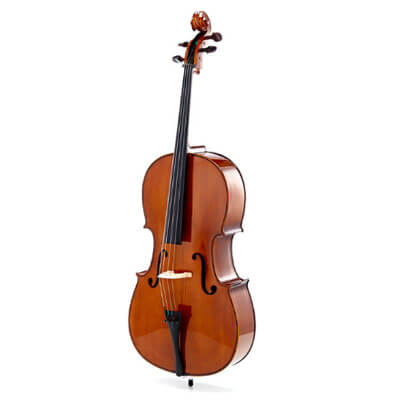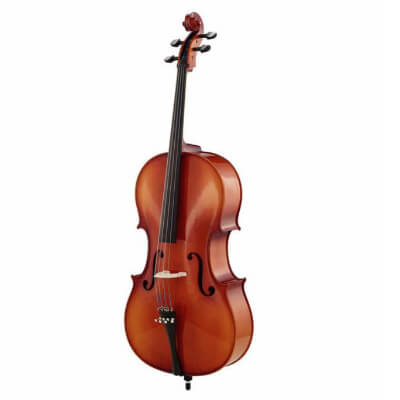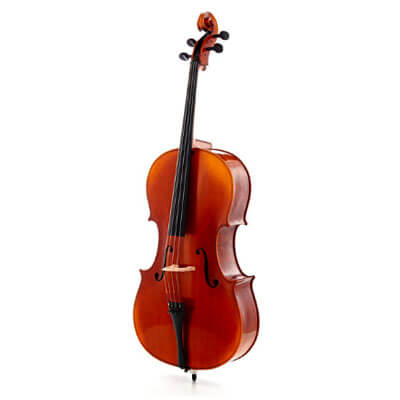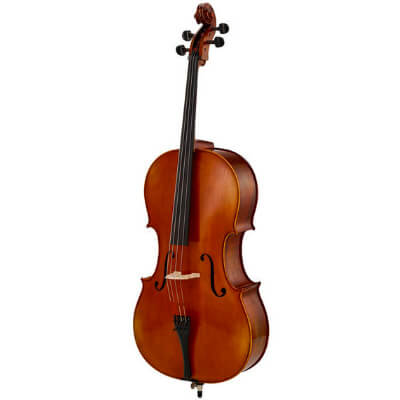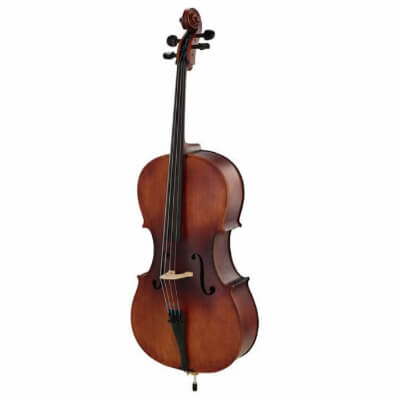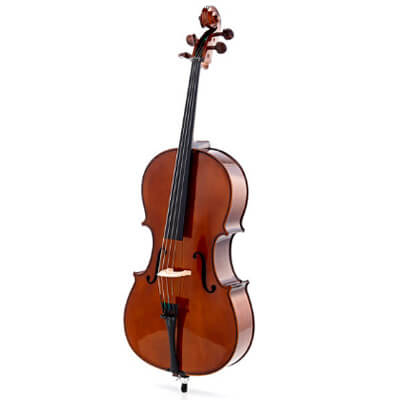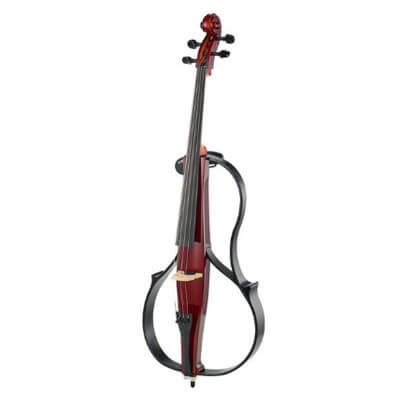Buying a cello: My 7 best recommendations 2025
This guide will help you find the right cello for you. I have selected suitable cellos for beginners, advanced players and kids. The answers to the frequently asked questions will help you make your choice.
This text has been translated into English. Please report spelling mistakes to sebastian@musiksocke.com
What kind of cello are you looking for?
Frequently asked questions:
Cello for beginners
Beginners should choose good cellos in the lower price segment. Even here, there are instruments that are made of high-quality woods and have a good finish. Before buying, it is especially important to try out the instrument. When buying online, this is possible thanks to the right of return in the online shop.
A good cello for beginners is the Stentor SR1102 Student I. It offers good value for money and is used by many music schools. The workmanship is consistently good and the playability is decent. So you can learn the basics at your own pace. The quality of the strings has been spared, which is immediately noticeable when you first play the instrument. The strings should be replaced in time. The model is available in the sizes 4/4, 3/4, 1/2, 1/8 and 1/10.
The Roth & Junius RJCE 4/4 Student is a good cello to start with. The set consists of a cello, bag, bow and rosin, so you can start playing immediately. The sound is very good for a cello in this price segment, which is due to the good strings and the high-quality workmanship. I would only change the bow if you notice that you spend more time with your new hobby. Overall, a good choice for beginners.
Cello for advanced players
If you are an experienced cellist, you should buy a high-quality instrument. The cello must have a pleasant and warm sound across the entire tonal spectrum. In addition to high-quality workmanship and the use of well-seasoned wood, the strings should also be optimally matched to the instrument.
The Yamaha VC 7SG44 Cello 4/4 is a good cello that is suitable for advanced cellists. It is handmade and uses only the best pieces of spruce, maple and ebony wood. The strings produce a warm and full sound and have an easy response. The set includes a bag, bow and rosin. A great cello to take from an inexpensive model to the next level.
The Lothar Semmlinger No. 132 cello 4/4 in Stradivari style is suitable for advanced players. The strings are made by Larsen and Thomastik and produce a great deep sound with lots of bass in combination with the instrument. You can tell that a lot of thought has gone into the combination. You can start right away and don’t have to search for the best strings for this cello. The cello has a high-quality finish, but no other accessories are included.
Cello for kids
In order for kids to be able to play their instrument without any problems, it has to be adapted to their body size. Most adults play on a 4/4 cello. Smaller sizes are available for kids. Which one is the right one can be determined by the length of the kid’s arm. For an arm length of 45 to 50 cm, a 1/4 cello is recommended. Up to 55 cm a 1/2 cello is suitable and at a length of 55 to 60 cm the kid should be provided with a 3/4 cello.
The cello, which is adjusted to the correct size, enables the kid to neatly grasp the notes on the fingerboard and to hold the instrument with the legs.
The Thomann Classic Cello Set 3/4 is an affordable cello for kids. It is available in the sizes 1/2, 1/4, 1/8 and 3/4. The workmanship is simple, but sufficient for kids’ first steps. The bridge still needs to be adjusted correctly, which can be done alone with a little manual skill. Or you can invest a few euros in a luthier who will adjust everything. With this cello, you have a little more effort, but you get a good instrument at a low price. The set includes a bag with a music compartment, a bow and some rosin for the strings.
The Stentor SR1102 Cello Student I is a good cello for kids. I also recommend this cello for adult beginners in the 4/4 size because it is solidly built and easy to play. The basics of cello playing can be learned easily. The 3/4 and 1/2 sizes are also suitable for kids. Only the strings could be changed after the initial phase to produce an even better sound. A bag and bow are included in the set. In this price category, one of the best cellos for the little ones.
Cello for crazy people
For experienced cellists who would like to try something new, an electric cello is ideal. These have an unusual and changeable sound that opens up new ways of making music. In addition, electric cellos have a very special and eye-catching style because they do not have a sound box. A popular electric cello is the Yamaha SVC 110 Silent Cello. Colourful cellos in blue, pink or purple that are guaranteed to get you noticed are also available.
A true cello for crazy people – not only because of the price – is this instrument:
How do I recognize a good cello?
A basic rule for high-quality cellos is that they are handmade. This makes the purchase a lot more expensive, but the cello then has a high-quality finish and thus a full sound. In the meantime, there are also instruments that are partly industrially manufactured and have a good sound.
Another indication of a high-quality cello are the tuning pegs with which you tune the strings. They should be easy to turn, but not too loose, so that the cello does not go out of tune while playing.
Important for a good cello is the balanced string action. The strings should not lie too high on the bridge. Otherwise they are difficult to grip. They should also not be too low, so that the vibration of the strings does not cause a clatter when playing.
The workmanship of the various wood components is also crucial. The gluing must not have any defects and must join the components firmly together without any gaps. Sharp edges or unclean edges must not appear anywhere on the instrument.
The woods used have a direct effect on the fullness of sound. It makes sense to use solid woods. Some manufacturers also use plywood for the very inexpensive models. However, such an instrument should be played extensively to determine whether it still has the typical cello sound with all its facets.
What accessories do I need?
If you want to start playing the cello, it is not enough to just get an instrument. Probably the most important thing you need in addition to playing is the bow. This is usually made of horsehair. Our recommendations often include a bow in the set. If you would like to try something different, you should have a closer look at the Alfred Stingl by Höfner AS23C 4/4 cello bow made of genuine Mongolian horsehair.
The bow must be treated regularly with a special resin called rosin. This allows the bow to adhere to the string. Probably the most popular product among cellists is the Pirastro Oliv/Evah Pirazzi 900100 rosin with a well-balanced grip on the strings.
The strings are also important. Inexpensive cellos in particular can be upgraded enormously with a new set of strings. Among the many products, it is difficult to make the right choice. The only thing that helps is to try them out, because it is a very individual decision and the bow used and the instrument have to work together. A good sound is produced by the Thomastik Spirocore 4/4 M. This set of 4 strings in medium tension should suit most cellists.
An instrument as expensive as a cello needs the right care. Fluctuations in temperature and changes in humidity can take their toll on the instrument. A humidifier helps against this. The Paganini humidifier is a hose that you fill with water and hang in the F-hole. This prevents the inside of the cello from becoming too dry. This prevents cracking and increases the life of the instrument. In my opinion, this simple version is sufficient.
With a stand, the cello can be placed safely. Therefore, special attention should be paid to stability. Of course, the support points of the musical instrument must be covered with rubber or another soft material so that the cello is not damaged. It is also practical if the stand has a built-in bow holder. This is the case with the K&M 14130. It is a very stable stand that is easy to adjust in width. I think it also looks good and I put my cello in the stand all the time.
In addition, you need a case or a bag in which the cello can be safely transported. In terms of price, there is no upper limit in this area either. A cello case made of carbon shell with 100% carbon fibre fabric can cost more than an instrument. In my opinion, however, the Gewa Air 3.9 Cello Case is perfectly adequate.
What are the best cello brands?
Through a survey among experienced musicians, I was able to find out the best brands. Only established brands that have been convincing with their high quality for many years made it into the list.
How much does a good cello cost?
A good cello costs between 2,000 and 5,000 euros. For beginners, however, there are also cheaper models in the range of 500 to 1,000 euros. The difference lies mainly in the manufacturing process: the inexpensive cellos for beginners are made industrially in a factory. Advanced players resort to good cellos made by hand.
Here is my recommendation for a good cello.
What is the best cello for beginners?
As a cello for beginners, the Stentor SR1102 Cello Student I 4/4 is suitable for about 700 euros. It has an excellent price-performance ratio and is easy to play. With an upgrade to better brand strings, you can get along well with this cello for the first few years.
For advanced musicians, the Yamaha VC 7SG44 Cello 4/4 is suitable for about 2,300 Euros. It has a beautiful, warm, full tone and offers experienced cellists many possibilities. The VC 7SG44 can keep up with the cellos of renowned craftsmen’s workshops in terms of workmanship.
Here you can find more details about the cello for beginners.
⚠️
* For the links marked with a star, we receive a commission on a purchase. The price does not change for you. Please use our link and support the independent work of Musiksocke. Thank you very much!
✔️
The product recommendations made here are based on my experience and conversations with expert musicians. All products presented here meet the criteria of the checklist.
🏦
All prices are incl. VAT plus shipping costs. The amount was estimated by me and may differ from the actual price. As an Amazon partner, I earn on qualified sales. This also applies to Thomann, Kirstein and all other partners.
String instruments:
Wind instruments:
Key instruments:
Drums:
Recording:


